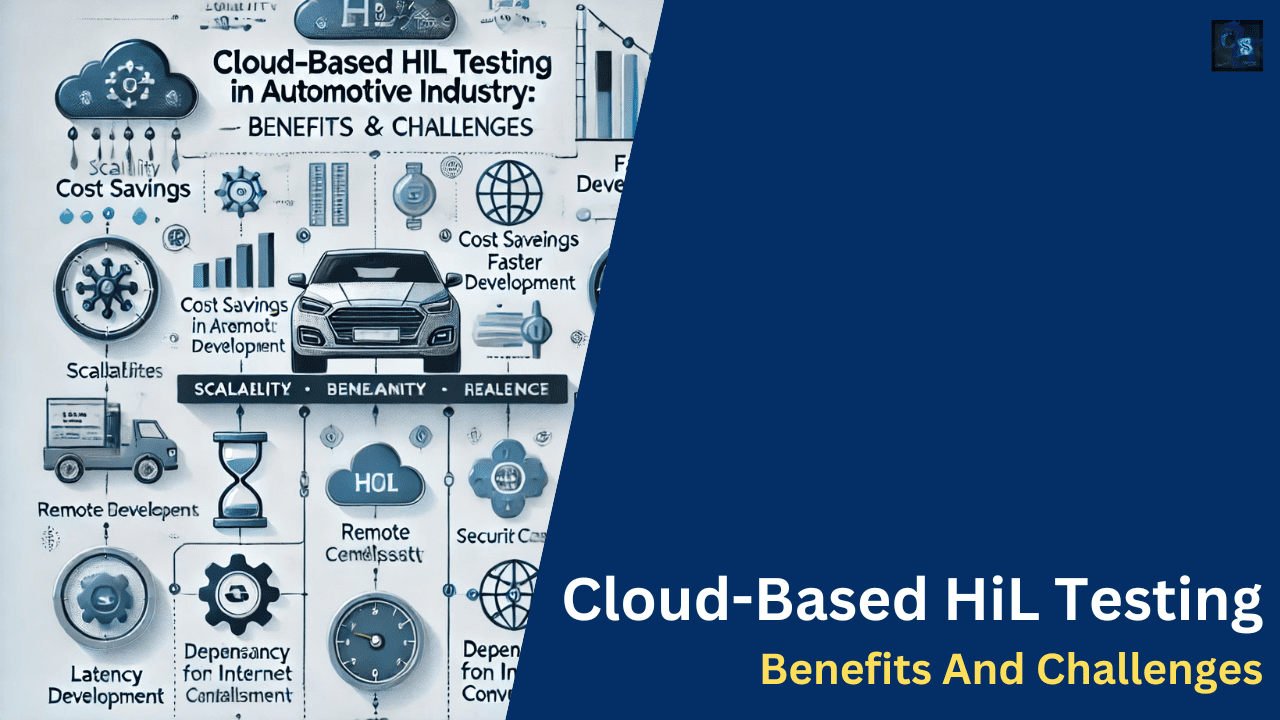Cloud-Based HiL Testing: Benefits And Challenges
Hello guys, welcome back to our blog. Here in this article, I will discuss cloud-based HiL testing, its benefits compared to traditional HiL testing, and its challenges.
Ask questions if you have any electrical, electronics, or computer science doubts. You can also catch me on Instagram – CS Electrical & Electronics
- List Of Automotive Companies: OEMs, Product-Based, And Service-Based Firms
- A Complete Guide To FlexRay Automotive Protocol
- EV Battery Recycling: Challenges and Future Solutions
Cloud-Based HiL Testing: Benefits And Challenges
Hardware-in-the-loop (HiL) testing is a crucial part of validating complex control systems in industries such as automotive, aerospace, and industrial automation. As technology evolves, cloud computing has started transforming the traditional HiL setup, enabling engineers to leverage remote access, enhanced scalability, and cost efficiency. Cloud-based HiL testing is an innovative approach that integrates traditional HiL methodologies with cloud infrastructure, allowing global teams to collaborate in real-time.
This article delves into the fundamentals of Cloud-Based HiL testing, its advantages, challenges, and future implications for industries relying on advanced simulation techniques.
Understanding Cloud-Based HiL Testing
HiL testing involves integrating real hardware components with a simulated environment to test embedded systems in real-time conditions. Traditional HiL setups rely on physical hardware, test benches, and dedicated infrastructure. Cloud-based HiL testing, on the other hand, shifts the computational and data processing requirements to cloud platforms, making testing more accessible and flexible.
With cloud-based HiL, companies can set up virtualized test environments where engineers can remotely access simulation models, execute test cases, and analyze results without being confined to physical testing laboratories. This approach enables a more efficient and cost-effective method of validation, particularly for organizations involved in global product development.
Benefits of Cloud-Based HiL Testing
01. Scalability and Flexibility
Cloud-based HiL systems provide on-demand resources, allowing organizations to scale their testing environment as needed. Unlike traditional HiL setups that require fixed hardware investments, cloud infrastructure can dynamically allocate processing power and storage based on project demands. This flexibility is crucial for companies working on multiple vehicle variants or control systems that require different configurations.
02. Cost Reduction
One of the most significant advantages of cloud-based HiL testing is cost savings. Traditional HiL setups require substantial investments in specialized hardware, software, and maintenance. With cloud-based solutions, companies can reduce infrastructure costs by shifting to a pay-as-you-go model, eliminating the need for expensive on-premise test equipment. This cost efficiency is particularly beneficial for startups and small businesses looking to optimize their resources.
03. Remote Accessibility and Collaboration
Cloud-based HiL testing enables engineers from different geographical locations to access testing environments remotely. This feature enhances collaboration among global teams, facilitating faster development cycles and real-time issue resolution. Remote accessibility also minimizes travel costs associated with physical testing at dedicated HiL labs.
04. Continuous Integration and Continuous Deployment (CI/CD)
Cloud platforms support seamless integration with DevOps workflows, allowing organizations to implement Continuous Integration and Continuous Deployment (CI/CD) pipelines. This integration ensures automated testing at various development stages, leading to faster bug detection and improved software reliability.
05. Enhanced Data Management and Analytics
Cloud-based HiL systems provide robust data storage, management, and analytics capabilities. Engineers can leverage cloud-powered machine learning and AI tools to analyze large datasets, extract insights, and optimize test performance. This data-driven approach improves decision-making and enhances the accuracy of validation processes.
06. Cybersecurity and Backup Solutions
Cloud service providers offer advanced security measures such as encryption, access control, and automated backups, ensuring the safety and integrity of test data. Compared to traditional on-premise setups, which may lack adequate security frameworks, cloud solutions provide a more secure environment for handling sensitive automotive and aerospace data.
Challenges of Cloud-Based HiL Testing

01. Latency and Real-Time Constraints
One of the biggest challenges in cloud-based HiL testing is maintaining real-time performance. HiL testing involves real-time simulations, requiring ultra-low latency between hardware and simulation models. Cloud environments introduce network delays, which can affect the accuracy and responsiveness of HiL systems, particularly in time-critical applications like autonomous vehicles and aerospace systems.
02. Security and Compliance Risks
Storing and processing sensitive test data in the cloud raises concerns about cybersecurity and compliance. Industries such as automotive and aerospace must adhere to strict regulatory standards (e.g., ISO 26262, ASPICE, GDPR). Ensuring that cloud-based HiL solutions meet these compliance requirements is a significant challenge that companies must address.
03. Integration Complexity
Migrating traditional HiL systems to the cloud involves significant changes in infrastructure, software compatibility, and integration with legacy systems. Ensuring seamless interoperability between cloud platforms and existing test environments requires careful planning and investment in specialized tools.
04. Dependence on Internet Connectivity
Cloud-based HiL testing relies heavily on stable internet connectivity. Any network disruption can lead to test failures, delayed development timelines, and potential data loss. Organizations must implement redundant connectivity solutions to mitigate this risk.
05. High Initial Investment in Cloud Infrastructure
Although cloud solutions reduce long-term operational costs, the initial investment in setting up a cloud-based HiL system can be significant. Organizations must invest in cloud migration strategies, training programs, and software adaptation to ensure a smooth transition from traditional HiL setups.
Applications of Cloud-Based HiL Testing
01. Automotive Industry
Cloud-based HiL testing is widely used in automotive applications for validating Electronic Control Units (ECUs), Advanced Driver Assistance Systems (ADAS), and autonomous vehicle functionalities. The ability to conduct remote testing accelerates the development of next-generation automotive technologies.
02. Aerospace Industry
In aerospace, HiL testing is essential for verifying flight control systems, avionics, and navigation modules. Cloud-based solutions enhance collaboration among global aerospace teams, improving efficiency in simulation and validation processes.
03. Industrial Automation
Industrial automation systems, including robotics and manufacturing control units, benefit from cloud-based HiL testing by enabling remote monitoring, predictive maintenance, and real-time performance analysis.
Future of Cloud-Based HiL Testing
The future of Cloud-Based HiL testing looks promising as industries continue to adopt digital transformation strategies. Advancements in edge computing and 5G networks will likely address latency issues, making real-time cloud-based HiL simulations more viable. Additionally, the integration of Artificial Intelligence (AI) and Machine Learning (ML) will further optimize test automation, predictive analytics, and fault detection in HiL environments.
Moreover, hybrid HiL solutions that combine cloud-based and on-premise testing approaches will likely emerge as a preferred model, balancing flexibility with real-time performance requirements.
Conclusion
Cloud-based HiL testing is revolutionizing the way industries conduct embedded system validation. By offering scalability, cost efficiency, and enhanced collaboration, it presents a compelling alternative to traditional HiL setups. However, challenges such as latency, security risks, and integration complexities must be addressed to ensure widespread adoption.
As technology continues to evolve, cloud-based HiL testing will play a critical role in accelerating product development, improving software quality, and driving innovation across various industries. Organizations that strategically invest in cloud-enabled HiL infrastructure today will be well-positioned to lead the next wave of digital transformation in system validation and testing.
This was about “Cloud-Based HiL Testing: Benefits And Challenges“. Thank you for reading.
Also, read:
- 100 (AI) Artificial Intelligence Applications In The Automotive Industry
- 2024 Is About To End, Let’s Recall Electric Vehicles Launched In 2024
- 50 Advanced Level Interview Questions On CAPL Scripting
- 7 Ways EV Batteries Stay Safe From Thermal Runaway
- 8 Reasons Why EVs Can’t Fully Replace ICE Vehicles in India
- A Complete Guide To FlexRay Automotive Protocol
- Adaptive AUTOSAR Vs Classic AUTOSAR: Which One For Future Vehicles?
- Advanced Driver Assistance Systems (ADAS): How To Become An Expert In This Growing Field



